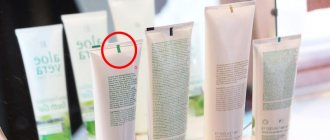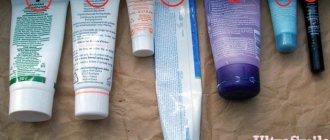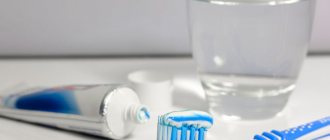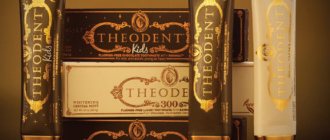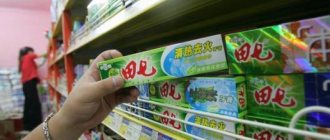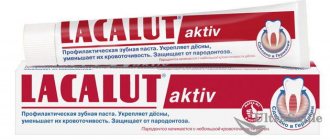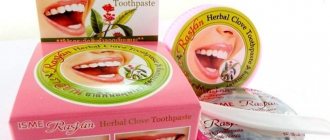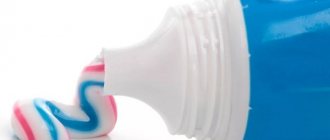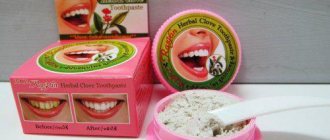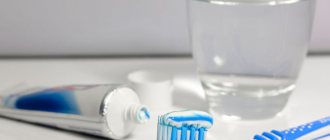There are so many different myths about what the colored stripes on toothpaste tubes mean. Allegedly, they are talking about harmful substances, the permitted frequency of using the paste, and what country or city it was actually made in. The most advanced manufacturers began to produce toothpastes in tubes with a green stripe, supporting the myth of their naturalness. But in fact, such assumptions are wrong, and any dentist can confirm this.
Basic myths about color marks on tubes
According to some consumers, the colors of the stripes on tubes of toothpastes, ointments and creams indicate the characteristics of their composition:
- Red is about synthetic.
- Green is about the environment.
- Blue and brown indicate that the product is half natural.
- Black - contains only chemical components.
Another part of consumers is of the opinion that colored markers indicate the degree of abrasiveness, the presence of protective properties, or the cost of hygiene products.
| Color of the strip on the paste tube | Number of abrasive particles | Protective properties | Price |
| Red | Few | Although it contains synthetic components, it provides the required degree of enamel protection. | Expensive product |
| Green | No | Effectively protects teeth and oral cavity from diseases thanks to its ecological composition | average cost |
| Blue, black, brown | A lot of | Has a low degree of protection, provokes periodontal disease | Cheap remedy |
Animal testing
Deciphering the signs on the labels will be extremely important for those who are concerned about our little brothers. The ethical standard was approved by the British Union and expresses the concept of unacceptable testing of any products on animals. This also applies to the presence of animal products in the composition.
Thanks to special signs on the label or packaging of cosmetics, the buyer can be sure that the purchased units of a particular brand are not tested on animals , which has been a mandatory condition for EU countries since 2009. There are a lot of ethical brand icons, but all of them are depicted in the form of a white bunny jumping or in profile. Also, similar symbolism can be found in the form of inscriptions with a corresponding picture.
The caption may mention the phrase “Animal friendly” or “Not tested.” It is important to pay attention to such inscriptions and labeling of products if you are against testing chemical and household products on animals.
GOST and multi-colored stripes
A modern tube of toothpaste made in Russia must comply with three GOST standards at once:
- GOST 7983-99 (based on ISO 11609-95) talks about the correct marking of a paste mass and what it means.
- GOST 14192 and 28303 indicate the requirements for containers.
These documents state that:
- It must be indicated on the tube:
- Product name;
- brand;
- trademark;
- volume;
- compound;
- acceptable storage conditions;
- best before date;
- availability of relevant certificates.
- The marking is applied in the language of the manufacturer and the importing country.
- Permissible deviations from weight are 5%.
- Containing materials must be environmentally friendly.
But none of the GOSTs talks about the meaning of colored stripes on toothpaste and the rules for applying them. That is, the state does not regulate in any way the procedure for applying a “color barcode” ; the company itself decides the issue of marking toothpaste with colored stripes and can do without these designations.
Symbols of environmental safety
Such badges confirm the environmental friendliness of the brand and its complete safety for the end customer. It could be:;
Apple
This symbol indicates brands that contain no carcinogenic or toxic substances in their products.
Letter "E"
Indicates safe brands that exclude toxic and dangerous components in the composition. Also, this sign confirms that the brand does not have an adverse effect on the atmosphere and nature. The symbols are applicable on the territory of Russia.
Leaf of Life
This image reflects voluntary testing for environmental friendliness of products by the manufacturer. Displays relevant certification.
Eco Test Plus
Russian system for assessing final brand products, developed in 2004. This certification includes packaging and containers, hygiene products, perfume lines, water, and wood products. Lines that have received this certification comply with environmental standards and exclude the use of herbicides, dyes, and silicone preservatives.
Environmentally friendly product
Russian organization designating the labeling of clean and safe brands. Displays certification of premium quality natural and organic cosmetics.
EU ecolabel
Was introduced in 2001. Positioned as a single eco-brand of European goods. Such an image of a flower can only be printed on those labels that meet all the requirements of EU eco-standards, namely: the absence of harmful and pathogenic substances, appropriate disposal, preservation of environmental friendliness during the production and disposal of containers, packaging material and the product itself.
Why are multi-colored stripes applied?
In fact, the colored stripes on the tubes are an identification mark for the conveyor during automated production. They are necessary for high-quality separation of the tube blank from the conveyor belt.
Stripes on pastes
The technological sensor detects the color marking and cuts off the future tube of toothpaste. After this, the plastic sheet is twisted, glued and filled with gel content. After these manipulations, the tube is finally glued and closed with a cap.
The color of the mark on toothpaste, by and large, means nothing. The manufacturer can independently choose the range and height of the strips, regardless of the chemical composition of the product and the shape of the container.
Streaks on creams
Creams are marked as the products move along the conveyor belt in a non-contact manner using special color markers read by conveyor sensors. They allow you not only to correctly cut and solder the tube, but also indicate places for applying drawings and text on the container.
Information about the composition and manufacturer is applied by inkjet using special ink. That is, red, black and other stripes are needed only in the process of producing creams using robotic technology.
Certification marks for ECO and BIO natural cosmetics
Natural, biological cosmetics are in demand among buyers; they are willing to pay huge amounts of money for them. The buyer pays mainly for the image of the sign of such cosmetics on the packaging. It’s one thing for a manufacturer to simply write that cosmetics contain natural ingredients; it’s quite another thing if this is confirmed by relevant certificates and laboratory studies. Products with the ECO and BIO logos must comply with a number of requirements and standards; they must contain ingredients of natural origin, components of plants that grew in environmentally friendly places. The presence of flavors, synthetic preservatives, petroleum products, and dyes is excluded. At the same time, the label for natural cosmetics must contain relevant information, in particular the percentage of BIO ingredients.
It is worth noting that in Europe there are no uniform state quality marks. Certificates are issued by organizations that have special laboratories and experts in the relevant industry. The following symbols of certification organizations can be found on the packaging of imported cosmetics.
In Russia there is also a system of voluntary certification of organic and natural cosmetics “Bio.rus”. The creators of this system were the non-profit organization “Scientific Society of Cosmetic Chemists” (NOCH). They developed a standard for such cosmetics, quality control, production principles, and ingredient requirements. The standard specifies natural ingredients that can be used in bio-based cosmetic products.
Manufacturers of natural cosmetics also choose appropriate packaging; they choose natural materials or those that can be recycled.
The True Meaning of Flowers
Despite the simple explanation for the appearance of stripes on toothpaste tubes, a certain color is chosen for a reason. The choice of mark shade is influenced by:
- Tube color. A black (dark) stripe on the toothpaste means that the main tone of the blank and tube is white or just a light shade. Light marks are typical for dark-colored containers, but manufacturers who decide to choose this shade of marker take a risk, since the photo sensor may not “catch” it during the soldering process.
- Limited choice. Typically, the marking involves 4 basic shades (CMYK - Cyan Magenta Yellow Black). Additionally, a fifth color can be used to print a barcode, text, or one light mark.
That is, the correct reading of the marking by the optical sensor depends on the contrast of the stripe and the main color of the tube. Most often, the tags are darker than the background, which allows the sensors to read the necessary information most efficiently.
When choosing a marker shade, packaging design is no less important. This means that if there are blue elements on a tube of toothpaste, then the stripe on it will be blue. Since the stripes on tubes of creams and pastes do not mean anything important (impact on the enamel), they can easily be replaced by other design elements at the discretion of the manufacturer.
Technological photo marks can be divided into 2 types based on their position on the sheet:
- horizontal markers are placed for precise cutting of the main workpiece when printing on a rolled laminate;
- vertical marks are needed to accurately indicate the location of the cut when soldering the tube, so that it is parallel to the main text and image on the final product.
Green dot sign
It consists of two arrows that form a circle. The sign can be of different colors: black and white, green, green and white - the choice depends on the packaging design, otherwise there is no difference. The meaning remains the same - it is applied to the products of companies that are participants in the program for collecting, sorting, and recycling waste in Germany, and invest funds in this project. This sign may indicate packaging that is safe for users. It can often be found on cosmetic products. It is worth noting that the presence of such a sign indicates that the product was definitely manufactured in Germany; manufacturers from other countries do not have the right to use it.
Labeling procedure
Color division depends on the equipment and the number of coloring sections. At the preparatory stage, one main color is taken, which will contrast most with the color of the tube. Based on it, the features of reading elements and printing a barcode are determined.
If you use two colors at once, for example, blue and black, this will lead to unreadable text when the equipment is moved. Optical sensors correctly capture one primary color (red, green). Most often, white color is used for the background, since all the colored stripes are clearly visible on white tubes; the height and width of the marks are discussed individually. This approach allows us to minimize the costs of producing and placing information on tubes using a printed, non-contact method.
But the color of the marking has nothing to do with the composition of the gel. Typically, the tubes are manufactured by a company that has nothing to do with the development of the personal care product itself and dentistry, so its labels simply by definition cannot refer to the chemical composition of the paste-like mass. If stripes on toothpaste mean anything, it clearly doesn't matter to the end consumer.
Depending on the required parameters of the tube, a large blank sheet is divided into parts of a certain size. Light marks are placed as delimiters. They indicate the location of the incision to produce a tube of the required volume. Different colors of markers help identify manufacturing defects and other technological defects.
The stripes on toothpaste do not mean anything, so you don’t need to look closely at them and look for a secret sign in them. If you need to choose a paste with some specific indicators, you should look for information about them not in strips. The content of synthetic and natural substances in the gel can be found by reading the composition information posted on the tube.
Symbolism of prizes and competition awards
Participation in certain competitions gives manufacturers a chance to receive one or another distinction in the form of a badge. Such designations attract attention and distinguish the company from its competitors. What kind of designations of awards and victories in competitions can be found on Russian-made products? It can be:
100 best goods of Russia
This event has been held every year since 1998. The competition logo confirms full compliance of the composition of the products with the declared ones.
All-Russian stamp
The winners of this award receive a corresponding badge in bronze, gold, silver or platinum. The presence of this mark on cosmetic products is prestigious and confirms the quality of the products produced. Every two years, the manufacturer must confirm compliance with the award standards in order to retain the right to print the award symbol on its products. In turn, this award confirms the naturalness, safety and modernity of the technologies of the noted cosmetic production.
People's stamp
This distinction is awarded to manufacturers who are considered the best, according to buyers.
The printing house “Labels 7 days a week” produces individual and stylish self-adhesive labels for cosmetics. For production we use exclusively high-quality materials and modern technical equipment.
We are ready now to surprise you with a large assortment of paper-based and synthetic base materials from leading brands on the European market. From us you can order labels from stylish matte, light semi-gloss, bright glossy and unusual metallized paper, polyethylene, ECO and TOP class thermal paper and classic polypropylene.
We take care of additional processing of the label in the form of embossing, embossing, partial or full varnishing, application of variable data, flattening into a sheet.
We develop an effective label design according to your requirements! Our professionals know how to create memorable and bright labels that will attract the buyer and contain all the necessary information about the product. Call +7 (495) 211-87-38 !
DD cream
DD cream or daily defense is a universal corrective product for the face. Manufacturers claim that this product combines all the advantages of previous alphabet creams. Although it was originally invented to moisturize dry areas of the skin, such as knees, feet, and elbows. But people are not ready to invest a lot of money in products for these zones, so manufacturers had to change vector.
This is how DD-face cream appeared, which can be called a universal product for every day. It contains SPF for sun protection, so it will help prevent premature aging. But it’s not entirely clear why this cream is positioned as a hybrid of BB and CC cream.
BEST BB CREAM
BB cream was invented by German dermatologists as a means for healing and restoring skin after deep peels and other cosmetic procedures. At first, Europeans did not appreciate the BB cream, but girls in Asia fell in love with it. It was thanks to Korean manufacturers that the cream entered mass sales.
By the way, the name of the BB cream stands for blemish balm (English: “healing balm”). It is perfect as a base for makeup, because it covers imperfections well and protects against UV rays. BB cream also provides the necessary hydration, helps make the complexion more even, and dries out inflammation. Recently, other products with mysterious names have appeared on the market: CC, DD, EE and even PP creams. Each of these products has its own function.
1 area of use
This standard applies to cosmetic creams, including cosmetic milk, cream, sour cream, emulsions, masks, peelings, scrubs, gel-based creams and other similar products that meet the requirements of this standard (hereinafter referred to as cosmetic creams) intended for the care of for skin, nails and hair.
Cosmetic creams are divided into emulsion, fat and gel-based creams (hereinafter referred to as gel creams).
Emulsion creams are divided into water/oil, oil/water and mixed type creams based on the type of emulsion.
Fat creams consist of fat components and special additives.
Cream-gels are colloidal systems containing water, fat emulsions, special additives and gel-forming components.
The standard does not apply to shaving creams.
Safety requirements are set out in 3.1.3 (pH), 3.1.4, 3.2 and section 4, labeling requirements are in 3.3.
